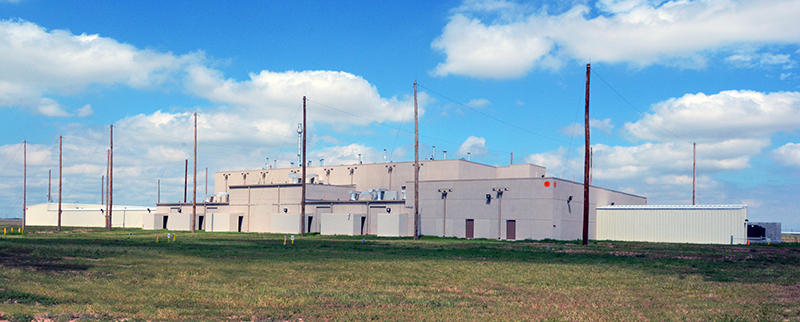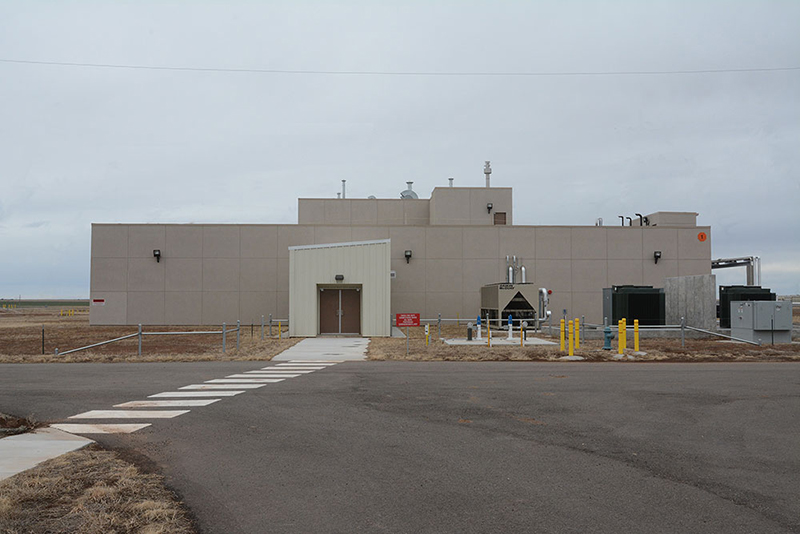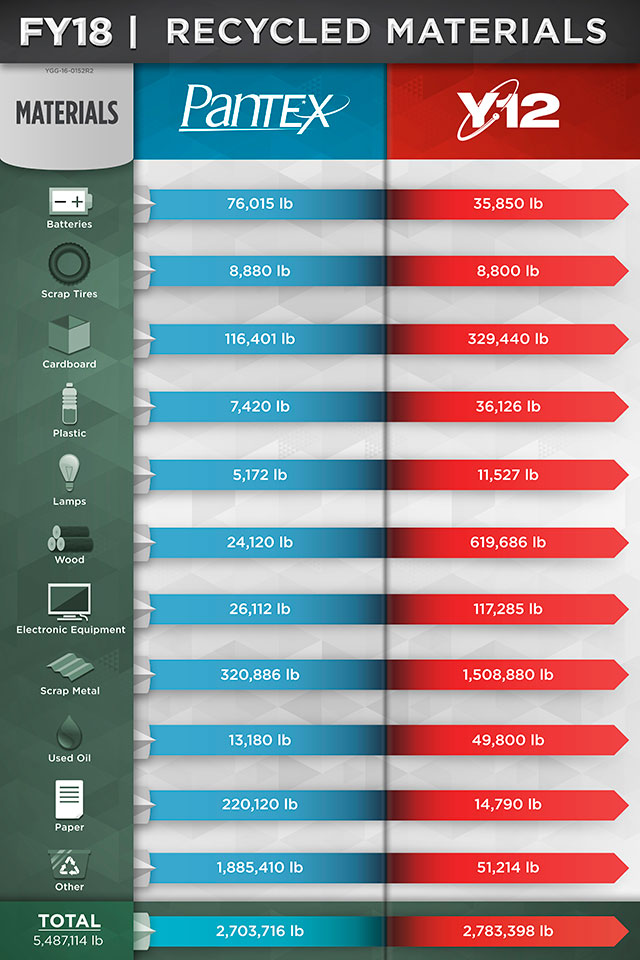Pantex Blog
Pantex celebrates Armed Forces Day
Alonzo Everhart, former Quartermaster First Class in the U.S. Navy, addressed an auditorium full of Pantex’s workforce Wednesday morning at a celebration recognizing the U.S. Armed Forces.
“Today we take time to thank our servicemen and women for preserving our freedom,” he said during the annual Armed Forces Day Celebration. “We thank them for their service, their sacrifice, and their commitment, while remembering that they need us to stand with them, and their families, while they are standing guard for us. We must continue to do our best for them, as they give their all for freedom.”
About 250 people attended the celebration at the John C. Drummond Center’s auditorium. The event was an opportunity for Pantex employees, veterans, and active duty military to show appreciation to those who have served and are still serving and remember fallen warriors.
Everhart is the senior director of Pantex Weapons Operations for Consolidated Nuclear Security, which operates the Pantex Plant and the Y-12 nuclear facility in Tennessee. He shared his story of growing up and serving in the Navy, and also spoke on his continued service to the country in his role at Pantex.
“I can imagine no more rewarding career,” he said. “And if asked what I did in my lifetime to make my life worthwhile, I will respond with a great deal of pride and satisfaction and say that I served in the United States Navy and continue to serve this great country while working at the Pantex plant.”
Bill Eckroade, the Deputy Field Office Manager in the NNSA Production Office at the Pantex Plant, shared his insights on initiatives being undertaken by the Department of Energy to support injured service members, specifically research on traumatic brain injuries utilizing the super computing systems within the DOE’s national laboratories.
Eckroade continued by sharing about the Purple Heart Trail that runs along I-40 across the U.S. from South Carolina to California. The stretch across the Texas Panhandle was the last section of the national trail to be designated.
“When the Purple Heart Trail on I-40 across the Texas Panhandle was designated, it completed the last link in a coast-to-coast national Purple Heart Trail,” he said. “Just as all roads lead to Pantex, all segments of I-40’s Purple Heart Trail led to this final stretch of highway – a stretch of highway that passes right by Pantex and the heart of our nation’s nuclear security infrastructure.”
Pantex Site Manager Todd Ailes shared that 20 to 25 percent of the Pantex’s workforce is made up of veterans and active duty military.
“Our work at Pantex is vital to national security and to our Armed Forces because our mission is to sustain a safe, secure, effective nuclear deterrent,” Ailes said. “As Pantexans, we have always taken great pride in meeting the needs of our Nation and we will forever play a part in carrying out the nuclear weapons mission.”
Wednesday’s celebration also included a tribute to prisoners of war and soldiers missing in action.
A simple, single table, known as the fallen soldier ceremony, was set up on the right side of the stage and Tori Hofeldt, former second class petty officer in the U.S. Navy, shared the symbolism behind each item on the table.
“This table, set for one, is small; symbolizing the frailty of one prisoner alone against oppressors,” she said. “The chair is empty. They are not here. We need to remember all who served with them and called them comrades. Until the day they come home: Remember.”
For more images of the celebration, please visit the Pantex Facebook site.
Pantex hosts NUWAIX 2019 exercise
Pantexans and supporting staff from Y-12 practiced taking appropriate protective actions, activating the Emergency Response Organization, and coordinating with other agencies during the 2019 Nuclear Weapons Accident/Incident Exercise April 24-29. Hosted at Pantex, this large-scale, full-participation exercise involved numerous local, state, and federal agencies including Carson County, Amarillo Police Department, FBI, Office of Secure Transport, Texas Department of State Health Services, Environmental Protection Agency and others.
While NUWAIX is held annually, hosting responsibilities rotate between DOJ, DOD and DOE, with DOE/NNSA leading every five years. The purpose of the exercise was to strengthen the ability of all involved to respond to the national, regional, and local effects of a scenario involving a nuclear weapon-related incident. The last DOE-led NUWAIX was in Grand Junction, Colorado, in 2014.
Daniel Gleaves with Pantex Emergency Services said, “The visibility provided by this exercise allows us to demonstrate our ability to respond to an emergency, builds confidence from DOE in the Pantex plant and our response capabilities.”
This year’s simulated scenario was incident-based (meaning an intentional act) and gave the participating agencies a chance to put their skills, procedures, postures, communications and coordination to the test. While the plant took protective actions, the Emergency Response Organization members from Pantex and supporting staff from Y-12 played their part on the scene, at the Emergency Operations Center, and the Joint Information Center. The plant was prepared for and received the deploying members of the Nuclear Emergency Support Team’s Accident Response Group to address the technical aspects of the scenario.
“At Pantex, you have a great emergency infrastructure here and you folks know that you are dealing with one of the most sensitive activities in the national nuclear enterprise,” said Jay Tilden, Associate Administrator and Deputy Undersecretary for Counterterrorism and Counter Proliferation. “There’s a certain level of safety here and procedural control that is exceptional. So, the idea that we would even have an accident is pretty low.”
“The NNSA must always be prepared for an emergency of any kind,” Tilden said. “Going through an exercise like NUWAIX 2019 is critical because it’s a complicated scenario requiring a lot of moving parts. And if we don’t exercise it, we may not be ready.”
There were approximately a thousand participants in the exercise, including hundreds of controllers and evaluators. Carson County Judge Daniel Looten, who participated in the exercise, said over the years he has come to know the Pantex emergency personnel through monthly meetings and mutual aid events.
“That trust and bond exists. I’m very secure to know that my citizens in Carson County are being very well protected and the people out here at Pantex do all they can to keep us safe,” Judge Looten said.
Throughout the exercise and tours, visitors were impressed with Pantex’s emergency preparedness. The objective of the event was met in that it gave the teams a chance to determine best practices and possible improvements.
For more images of NUWAIX 2019, see the Pantex Facebook site.
NNSA authorizes full-scale operations at the High Explosives Pressing Facility at Pantex Plant in Texas
WASHINGTON – The Department of Energy’s National Nuclear Security Administration (DOE/NNSA) has authorized full-scale operations at the Pantex Plant’s High Explosives Pressing Facility (HEPF) in Amarillo, Texas, following extensive readiness reviews.
The Pantex Plant is the Nation’s primary facility for the final assembly, dismantlement, and maintenance of nuclear weapons. Replacement of high explosives in weapons is an important part of NNSA’s mission to maintain and extend the life of the U.S. nuclear stockpile.
“NNSA is modernizing the Nuclear Security Enterprise to face 21st century threats,” said Lisa E. Gordon-Hagerty, DOE Under Secretary for Nuclear Security and NNSA Administrator. “Our dedicated stewards of the nuclear deterrent at the Pantex Plant deserve this modern, safe infrastructure to accomplish our team’s national security missions.”

HEPF replaces existing machining and pressing facilities that are over 50 years old and consolidates operations to reduce the movement of high explosives within the plant, increasing employee safety and minimizing impact to other plant operations.

NNSA broke ground on the 45,000 square-foot, state-of-the-art facility in 2011. Managed by the U.S. Army Corps of Engineers using a firm fixed price contract, construction was completed in 2017.
7 Ways Pantex Protects the Environment
“Greening” information technology
Pantex continues to acquire electronics products that are environmentally sustainable. During FY 2018, approximately 95% of monitors, computers, televisions and other imaging systems purchases were products that met the Electronic Product Environmental Assessment Tool criteria established by the Green Electronics Council. Nearly 100% of all computers and monitors save energy consumption by the use of power management tools.
Recycling to prevent waste
During FY 2018 Pantex recycling efforts resulted in the following quantities of waste shipped to various recycling companies:
7,420 lbs.
116,401 lbs.
320,886 lbs.
26,112 lbs.
208,837 lbs.
10,787 lbs.
1,750 lbs.
Following the rules
The Texas Commission on Environmental Quality conducted a waste site inspection of all hazardous and non-hazardous waste locations in accordance with the Annual Resource Conservation and Recovery Act including a records and permit review. This year’s inspection concluded no finding, weaknesses or observations making this the 24th consecutive annual RCRA waste site inspection with no violations.
Minimizing waste
Pantex continues to use digital technology (such as that used with the Radiography X-Ray machine used in the Pantex Occupational Medical Department) to eliminate the generation of silver contaminated film wastes and reduce annual waste generation. More than 1,000,000 metric tons of electronics equipment were disposed of through the use of certified recyclers or transferred or donated to other sites and/or educational institutions through various government programs. Accordingly, 99% of this type of equipment was not disposed of using landfills. In addition, more than 95% of all Pantex printers have duplex printing capabilities to save paper use.
Employing renewable energy
The Plant continues to use renewable energy-powered equipment such as solar-powered aerators in the wastewater lagoons, solar-powered lights at parking lots and solar-generated power to emergency notification towers. However, since the summer of 2014, the operation of the Pantex Renewable Energy Project or “wind farm” has allowed the Pantex site to consistently exceed DOE goals regarding the use of renewable energy and reduce energy-related greenhouse gas emissions.
Reducing energy intensity
Pantex has reduced energy intensity by 20 percent since 2015 primarily through the use of the Pantex Renewable Energy Project or “wind farm.” Energy intensity is the amount of energy used per square foot of plant’s foot print. By 2025, the goal is to reduce energy intensity by 25 percent from the 2015 baseline.
Conserving water resources
Water from a small aquifer beneath the Plant is pumped to the surface and treated to reduce contaminants. The water is then mixed with Pantex Wastewater Treatment Facility wastewater and beneficially reused to irrigate crops in the northeastern portion of Plant property. A similar use of the same water for “center-pivot” irrigations of a portion of the property east of FM-2373 is currently being investigated. In addition, Pantex has established several projects to reduce water consumption by eliminating where possible the use of “once-through” cooling systems.

Wild Pantex – Tracking Monarchs
Article by James D. Ray, Pantex Wildlife Biologist/Environmental Science Senior Specialist
In the early 1990s, I had the opportunity to affix coded tags to wings of dozens of monarch butterflies that volunteers and I captured during their southward migrations. My interest in these butterflies peaked again a few years later when Pantex Agronomist Monty Schoenhals impressed upon me to keep an eye on our local milkweeds for monarch caterpillars.
As both a beekeeper and a wildlife biologist, I have tuned in to increasing information that our populations of pollinators are suffering alarming rates of decline. A Presidential Memorandum released in 2014 led to the creation of a federal strategy to promote the health of pollinators, and this eventually filtered down to the Department of Energy-National Nuclear Security Administration Pantex Plant and other facilities within the DOE/NNSA complex.
Aeroecology - an area of technology that has long fascinated me - is the study of biota in the atmosphere using Nex Rad Weather Radar. The science is relatively new, but is developing rapidly, and is used for studies of insects, bats, and birds. During 2018, Pantex contracted with Dr. Jeffrey Kelly and the Aeroecology Group within the Plains Institute at the University of Oklahoma for research to evaluate whether Nex Rad Weather Radar could be used as a monitoring tool for the monarch butterfly and other pollinator species that migrate. I felt that since radar can detect tiny insects emerging from lakes and rivers, surely it could be used for some much needed monitoring of the declining monarch butterfly.
There are varieties of tools within radar technology that allow researchers to differentiate the shape of biota from that of raindrops, detect the heading of their flight, and even that they are compensating for the wind. Further analysis tools of radar aeroecology can estimate body size and population numbers within the sampling range of the radar for each scan. Preliminary results of our study look very encouraging. We recently shared our work at a conference in Texas, and we have submitted a proposal to give a presentation at a national level conference occurring in Reno, Nevada, this fall.
Declining populations of pollinators should be concerning to all of us because of the enormous benefits they provide to our society and ecosystems. It is the hope of Pantex, the University of Oklahoma, and the DOE-NNSA that this work result in a valuable monitoring tool that can be used amid many components that will likely be necessary to forward conservation efforts focusing on our declining pollinators.
Please feel free to share this link with others that enjoy wildlife or that appreciate entities that take great strides to contribute to wildlife conservation.

Photo 1. Monarch butterflies taking a rest on the DOE-NNSA Pantex Plant during their 2015 fall migration.

Photo 2. The blue in this radar image depicts what is estimated to be several million monarch butterflies passing over the Texas Panhandle on September 25, 2018.
